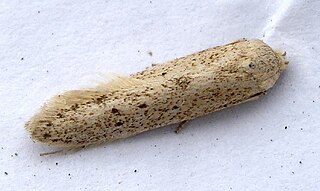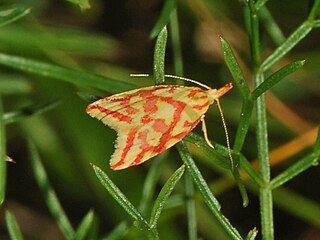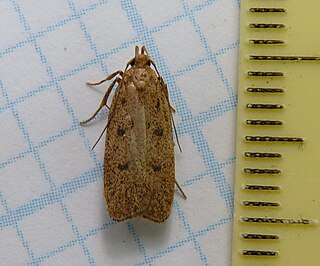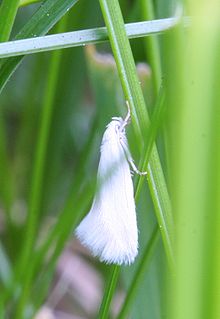
Oecophoridae is a family of small moths in the superfamily Gelechioidea. The phylogeny and systematics of gelechoid moths are still not fully resolved, and the circumscription of the Oecophoridae is strongly affected by this.

The Elachistidae are a family of small moths in the superfamily Gelechioidea. Some authors lump about 3,300 species in eight subfamilies here, but this arrangement almost certainly results in a massively paraphyletic and completely unnatural assemblage, united merely by symplesiomorphies retained from the first gelechioid moths.

Gelechioidea is the superfamily of moths that contains the case-bearers, twirler moths, and relatives, also simply called curved-horn moths or gelechioid moths. It is a large and poorly understood '"micromoth" superfamily, constituting one of the basal lineages of the Ditrysia.

The Coleophoridae are a family of small moths, belonging to the huge superfamily Gelechioidea. Collectively known as case-bearers, casebearing moths or case moths, this family is represented on all continents, but the majority are found in temperate areas of the Northern Hemisphere. They are most common in the Palearctic, and rare in sub-Saharan Africa, South America, and Australia; consequently, they probably originated in northern Eurasia. They are relatively common in houses, they seek out moist areas to rest and procreate.

Scythrididae is a family of small moths in the superfamily Gelechioidea. The family is sometimes included in the Xyloryctidae as a subfamily Scythridinae, but the Xyloryctidae themselves have sometimes been included in the Oecophoridae as subfamily. Scythrididae adults are smallish to mid-sized moths, which when at rest appear teardrop-shaped.

Blastobasis is the type genus of the gelechioid moth family Blastobasidae; in some arrangements these are placed in the case-bearer family (Coleophoridae) as a subfamily. Within the Blastobasidae, the subfamily Blastobasinae has been established to distinguish the Blastobasis lineage from the group around Holcocera, but the delimitation is not yet well-resolved.

The Depressariinae – sometimes spelled "Depressiinae" in error – are a subfamily of moths in the superfamily Gelechioidea. Like their relatives therein, their exact relationships are not yet very well resolved. It has been considered part of family Elachistidae sensu lato or included in an expanded Oecophoridae. In modern classifications they are treated as the distinct gelechioid family Depressariidae.

Depressaria is a moth genus of the superfamily Gelechioidea. It is the type genus of subfamily Depressariinae, which is often – particularly in older treatments – considered a distinct family Depressariidae or included in the Elachistidae, but actually seems to belong in the Oecophoridae.

Crassa is a genus of the concealer moth family (Oecophoridae). Among these, it belongs to subfamily Oecophorinae. The genus name Tichonia, established by J. Hübner in 1825, was frequently misapplied to these moths by earlier authors. But as the type species of Hübner's genus is the greenweed flat-body moth – originally described as Tinea atomella, but nowadays called Agonopterix atomella –, Tichonia is actually a junior synonym of Agonopterix. That genus does belong to the same superfamily as Crassa, but is placed in the concealer moth subfamily Depressariinae which is sometimes treated as distinct family.

The Amphisbatinae was a small subfamily of moths in the superfamily Gelechioidea. Like their relatives therein, their exact relationships are not yet very well resolved. The present lineage is often included in the Depressariinae as a tribe Amphisbatini, though more often within the context of a "splitting" approach to Gelechioidea systematics and taxonomy, wherein the Depressariinae are elevated to full family rank and the Amphisbatinae are treated as a subfamily therein. An even more extremely split-up layout even treats the Amphisbatinae as full family Amphisbatidae. In the scheme used here, the Amphisbatinae are included in the Oecophoridae as a subfamily alongside the Depressariinae.

Pseudatemelia is a genus of gelechioid moths.

The Symmocinae are a subfamily of moths in the superfamily Gelechioidea. These small moths are found mainly in the Palearctic and Africa.

Scythris is a genus of gelechioid moths. It is the type genus of the flower moth family, which is sometimes included as a subfamily in the Xyloryctidae, or together with these merged into the Oecophoridae. The genus was erected by Jacob Hübner in 1825.

Elachista is a genus of gelechioid moths described by Georg Friedrich Treitschke in 1833. It is the type genus of the grass-miner moth family (Elachistidae). This family is sometimes circumscribed very loosely, including for example the Agonoxenidae and Ethmiidae which seem to be quite distinct among the Gelechioidea, as well as other lineages which are widely held to be closer to Oecophora than to Elachista and are thus placed in the concealer moth family Oecophoridae here.

The Autostichinae are a subfamily of moths in the superfamily Gelechioidea. Like their relatives therein, their exact relationships are not yet very well resolved. The present lineage was often included in the concealer moth family (Oecophoridae), but alternatively it is united with the Symmocidae sensu stricto to form an expanded family Autostichidae.

Autosticha is a genus of gelechioid moths. It belongs to the subfamily Autostichinae, which is either placed in the concealer moth family (Oecophoridae), or in an expanded Autostichidae. It is the type genus of its subfamily. Originally, this genus was named Automola, but this name properly refers to a fly genus in family Richardiidae.

Luquetia is a moth genus of the superfamily Gelechioidea described by Patrice J.A. Leraut in 1991. It is mostly placed in the family Depressariidae, which is often – particularly in older treatments – considered a subfamily of the Oecophoridae or included in the Elachistidae.

Semioscopis is a moth genus of the superfamily Gelechioidea. It is placed in the subfamily Depressariinae, which is often – particularly in older treatments – considered a subfamily of the Oecophoridae or included in the Elachistidae.
Fuchsia is a genus of gelechioid moths and only genus of the Fuchsiini tribe. In some systematic layouts, it is placed in the subfamily Amphisbatinae of the concealer moth family (Oecophoridae). Delimitation of Amphisbatinae versus the closely related Depressariidae and Oecophorinae is a major problem of Gelechioidea taxonomy and systematics, and most authors separate the former two as full-blown families, and/or include the Amphisbatinae in Depressariidae, or merge them in the Oecophorinae outright.

Levipalpus is a moth genus of the superfamily Gelechioidea. It is placed in the family Depressariidae, which is often – particularly in older treatments – considered a subfamily of the Oecophoridae or included in the Elachistidae.

















